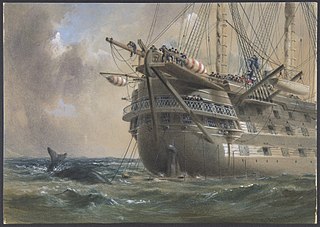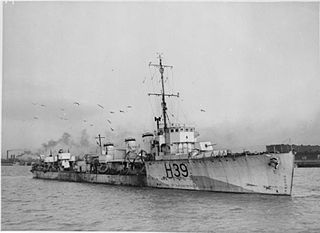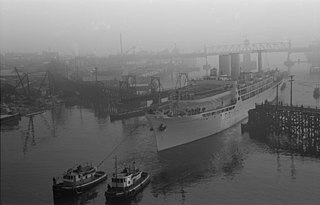
Standing Royal Navy deployments is a list of operations and commitments undertaken by the United Kingdom's Royal Navy on a worldwide basis. The following list details these commitments and deployments sorted by region and in alphabetical order. Routine deployments made by the Navy's nuclear-powered submarines and their location of operations is classified.

Minelaying is the act of deploying explosive mines. Historically this has been carried out by ships, submarines and aircraft. Additionally, since World War I the term minelayer refers specifically to a naval ship used for deploying naval mines. "Mine planting" was the term for installing controlled mines at predetermined positions in connection with coastal fortifications or harbor approaches that would be detonated by shore control when a ship was fixed as being within the mine's effective range.
In the Royal Navy and other navies of Europe and the Commonwealth of Nations, ships are identified by pennant number. Historically, naval ships flew a flag that identified a flotilla or type of vessel. For example, the Royal Navy used a red burgee for torpedo boats and a pennant with an H for torpedo boat destroyers. Adding a number to the type-identifying flag uniquely identified each ship.
Operation Stonewall was a World War II operation to intercept blockade runners off the west coast of German-occupied France. It was an effective example of inter-service and international co-operation.

HMS Agamemnon was a Royal Navy 91-gun battleship ordered by the Admiralty in 1849, in response to the perceived threat from France by their possession of ships of the Napoléon class.

HMS Adventure, pennant number M23, was an Adventure-class minelaying cruiser of the Royal Navy built in the 1920s that saw service during the Second World War. Her commander between 1928 and 1929 was the future First Sea Lord John H. D. Cunningham. Laid down at Devonport in November 1922 and launched in June 1924, Adventure was the first vessel built for service as a minelayer; she was also the first warship to use diesel engines, which were used for cruising. Adventure first joined the Atlantic Fleet, then was transferred to the China Station in 1935. In World War II, the ship was damaged in 1941 and 1944, and was converted to a landing craft repair in 1944. In 1945 Adventure was reduced to reserve and in 1947 she was sold and broken up for scrap.

HMS Skate was an R-class destroyer of the Royal Navy that was laid down and completed during the First World War. She was built at John Brown Shipyard at Clydebank in Scotland and launched on 11 January 1917.

HNLMS Zwaardvisch (S814) was the lead ship of the Royal Netherlands Navy's Zwaardvisch-class submarine, which was based on the British T class. The submarine was originally ordered as HMS Talent (P322) and built by Vickers Armstrong, Barrow. It served mainly in the Pacific against the Japanese during the war, operating under both British and US operational command in Ceylon and Australia. In 1950, the vessel was renamed HNLMS Zwaardvis. She was sold and broken up for scrap in 1963.

HMS Ariadne was an Abdiel-class minelayer of the Royal Navy.

The German ship Doggerbank was a UK cargo ship that was built in Scotland in 1926, captured by the German Navy in 1941, renamed Doggerbank and converted into an auxiliary minelayer and blockade runner. The German U-Boot U-43 (1939) sank her by mistake in 1943, leading to the deaths of all but one of her 257 passengers and 108 crew.
HMS M22 was a First World War Royal Navy M15-class monitor. Later converted to a minelayer and renamed HMS Medea, she was wrecked whilst being towed for breaking up on 2 January 1939.

MV Menestheus was a Blue Funnel Liner launched in 1929. She was requisitioned by the Royal Navy for conversion to the auxiliary minelayer HMS Menestheus. She joined the 1st Minelaying Squadron based at Kyle of Lochalsh laying mines for the World War II Northern Barrage.
An amenities ship is a ship outfitted with recreational facilities as part of a mobile naval base. Amenities ships included movie theaters and canteens staffed by mercantile crews of the Royal Fleet Auxiliary service. These ships were intended to provide a place where British Pacific Fleet personnel could relax between operations.

HMS Tarpon was a Royal Navy R-class destroyer constructed and operational in the First World War. She is named after the large fish Tarpon; one species of which is native to the Atlantic, and the other to the Indo-Pacific Oceans. Tarpon was built by the shipbuilders John Brown & Company at their Clydebank shipyard and was launched in March 1917 and entered service in April that year.
Five ships of the Royal Navy have been named HMS Minstrel after the medieval European entertainer Minstrel:
HMS M1 may refer to the following ships of the Royal Navy:









